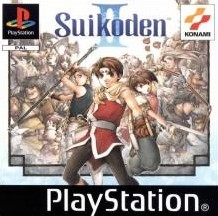Suikoden II (PlayStation) Review
By Drew Hurley  04.05.2015
04.05.2015

Suikoden II was originally released in Japan by Konami in 1998 on the original PlayStation, and it took until 1999 and 2000 to reach the United States and Europe, respectively. The game was later released on the PSP in Japan in 2005, yet sadly never reached Western shores. Until now. Much like how fans consider Final Fantasy VII to be the best of Square Enix's venerable series, Suikoden II is considered to be the best of Konami's series. The real question for newcomers and fans alike, though, is whether or not the game still holds up today. Cubed3 looked at the original Suikoden recently, after it hit the PlayStation Network, and now the sequel gets the review treatment.
The story continues a few years after the original title but follows a brand new protagonist as he gathers the 108 Stars of Destiny once more. Although the story is definitely one of the strongest aspects, it's hard to discuss much of it since there are numerous and significant twists that need to be experienced firsthand. The focal point is the relationship between the protagonist, Riou (or whatever is decided for his name), and his childhood friend, Jowy, following their journey from cannon fodder soldiers of the Highland Army to leaders of their own Army and the recruiting of significant characters from across the world, including some familiar faces from the original Suikoden. The story is considerably darker and more complex than that of the original. Instead of a simple overthrow of the evil Witch that is controlling the Emperor, there are much deeper motivations behind the bad guys here, apart from Luca. Luca is just an evil psycho.

The familiar faces from the original Suikoden make playing the original through to completion before playing this very worthwhile. It's not a necessity or requirement and there is no essential knowledge of the previous needed but seeing where characters are now and what they have been doing between the two games is great. Fans will likely be most interested in Flik and Victor who once again become prominent players in the story. On top of this, for those who played the original, it is possible to import the old save file and unlock some fantastic little features in this instalment. There are extra characters to recruit, reappearing ones that can get a bonus to their starting level, along with getting some extra equipment and there are even unique quests. When taking into account how long ago this game was released, it's very impressive to see these sorts of features being used.
Suikoden II is surprisingly well balanced when it comes to the main story plot and side-quests. Again, the player will find themselves backtracking to familiar areas to try and recruit all 108 Stars of Destiny. For those who have not played the original, the 108 Stars of Destiny are the characters that can be recruited to join the lead's army and to create a party from. Most RPGs have a cast larger than the party size for the player to craft a party group to their liking, but Suikoden uses a Pokémon-esque 'gotta catch 'em all' mindset, with a gargantuan amount to choose from. The gathering of these Stars makes up most of the side-quests and optional aspects of the adventure and the recruitments range from simply talking to an NPC while having a certain other character in as a member of the current party, through to foot races, random gambling endeavours, and even dance offs! Gathering the Stars is superb, especially for completionists, and something that other games should really look to emulate.
The combat system doesn't change up much from the original, with the underlying combat being turn-based where all commands are issued to the entire party and then all actions taken, as opposed to each character being commanded and then taking their action. The party setup is larger than most JRPGs - up to six characters - and with the massive cast of 108 Stars to choose from, the party setups can be varied and it is worth experimenting with different combinations thanks to the series' "Unite" attacks. When certain members are in a party together, they can perform these Unite moves instead of taking their individual commands. They are often extremely powerful and have some great unique animations - watching a Kobold ride a wild wolf while using a carrot on a stick or summoning a stampede of characters to trample enemies underfoot or just stylish massive attacks, for instance.

Suikoden II also reuses the same Rune-based equipment system as the previous. Runes are the source of all magic in the world and by attaching different ones to a character's weapon, they will gain a number of special abilities that have limited uses until the player rests. It's an interesting system that takes some getting used to but works very well when mastered. There are a wide range of varied abilities from the Runes that can be equipped and some characters come with their own unique Runes, too. It's a system that is both well thought out and well implemented and that offers a great deal of customisation for party setups, which greatly helps later in the game. When combat would usually be getting repetitive this helps to combat it, and on top of that the game implements an "auto" combat choice for when taking on weaker enemies, instead of having to just constantly go through the motions.
Suikoden also introduced two other types of combat, and these mini-game-esque encounters were one-on-one duels that played like a rock-paper-scissors-style battles and an army-vs-army combat, which... also played in quite a rock-paper-scissors scenario. While the duels return in the same way, the army-on-army aspect is completely redone. These now play more like a Fire Emblem-style mini-game, where the player and enemy take turns moving units around a grid and attacking. Sadly, the army-on-army feels like one of the weakest features - it's heavily simplified and doesn't give players much freedom.
There were a number of weaknesses of the original that have been somewhat addressed in Suikoden II, for example, the original had a short playtime in comparison to others of the genre, which is certainly addressed here, with plenty to do both on and off the beaten path. Even just following the story along to completion, there is easily over 30 hours' playtime here and that will approach 50 if wanting to get everything done.

Another of the previous weaknesses was that while it was a great amount of fun gathering all 108 Stars of Destiny in the original, most were quite unremarkable in terms of story. There were a handful of exceptions that had an impact on the overall story, yet mostly they joined up, ate food, slept, and just chilled out in the castle, repeating the same lines of dialogue. In this iteration, many of the Stars actually have interactions and story arcs along with actually development of their characters.
Finally, the inventory system of the original was a complete nightmare and something most players would end up spending a lot of time on for no real reward. Although it is slightly improved in this iteration, it still takes an unhealthy amount of time to deal with at points and can feel like a very unnecessary time sink.
While these improvements all take great strides, the game isn't flawless. The aforementioned inventory can be a pain, the difficulty is a little too easy, the start can feel very slow, and at points it's easy to get lost on just where to head next to progress. All of these are fairly minor complaints, though, when the game is looked at as a whole. There's a reason Suikoden II is remembered so fondly and it's not just the nostalgia goggles of its fans - there is a spectacular example of a JRPG here that is quite timeless in its appeal.

Cubed3 Rating
Exceptional - Gold Award

Easily one of the best JRPGs experiences ever. Suikoden II's story is fantastic and makes the player really care about the cast and what they are going through. The combat is fun and even grinding up some levels doesn't need to feel too grindy thanks to the auto-combat and the massive cast of characters. The side-quests are much deeper and collecting all the Stars of Destiny is fantastically addictive and enjoyable. Believe the hype, JRPG fans, this is a true classic that every fan of the genre needs to experience.

![]() 9/10
9/10
![]() 0
(0 Votes)
0
(0 Votes)
 Out now
Out now  Out now
Out now  Out now
Out now  Out now
Out now Comments
Comments are currently disabled

 Sign In
Sign In Game Details
Game Details Subscribe to this topic
Subscribe to this topic Features
Features






 Top
Top

